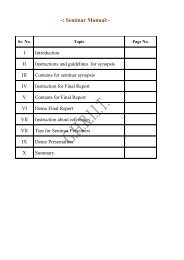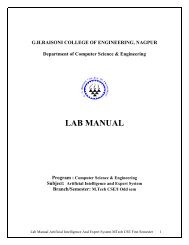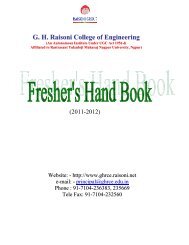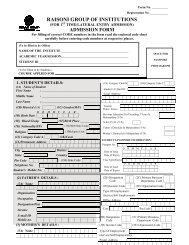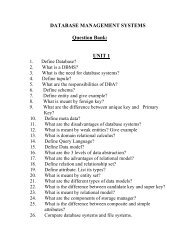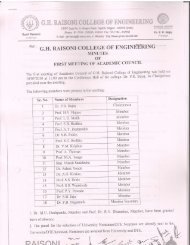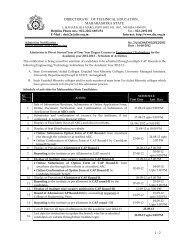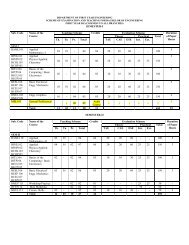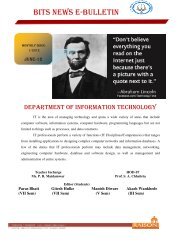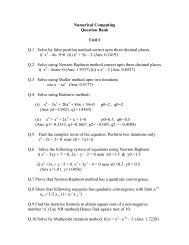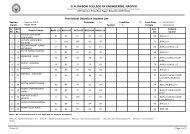DIGITAL SYSTEM DESIGN
DIGITAL SYSTEM DESIGN
DIGITAL SYSTEM DESIGN
Create successful ePaper yourself
Turn your PDF publications into a flip-book with our unique Google optimized e-Paper software.
UNIT I:<br />
<strong>DIGITAL</strong> <strong>SYSTEM</strong> <strong>DESIGN</strong><br />
Introduction to VHDL, design units, data objects, signal drivers, inertial and transport<br />
delays, delta delay, VHDL data types, concurrent and sequential statements.<br />
UNIT II:<br />
Subprograms – Functions, Procedures, attributes, generio, generate, package, IEEE<br />
standard logic library, file I/O, test bench, component declaration, instantiation,<br />
configuration.<br />
UNIT III:<br />
Combinational logic circuit design and VHDL implementation of following circuits –<br />
first adder, Subtractor, decoder, encoder, multiplexer, ALU, barrel shifter, 4X4 key board<br />
encoder, multiplier, divider, Hamming code encoder and correction circuits.<br />
UNIT IV:<br />
Synchronous sequential circuits design – finite state machines, Mealy and Moore, state<br />
assignments, design and VHDL implementation of FSMs, Linear feedback shift register<br />
(Pseudorandom and CRC)<br />
UNIT V:<br />
Asynchronous sequential circuit design – primitive flow table, concept of race, critical<br />
race and hazards, design issues like metastability, synchronizers, clock skew and timing<br />
considerations.<br />
UNIT VI:<br />
Introduction to place & route process, Introduction to ROM, PLA, PAL, Architecture of<br />
CPLD (Xilinx / Altera).
TEXT BOOKS:<br />
1. VHDL – 3 rd Edition – Douglas Perry – TMH<br />
2. Fundamentals of Digital Logic with VHDL design – Stephen Brown, Zvonko<br />
Vranesic – TMH.<br />
3. Digital Design Principles – Fletcher.<br />
4. VHDL Synthesis – J Bhasker.<br />
5. VHDL Primer – J Bhasker – Pearson Education.<br />
REFERENCE BOOKS:<br />
1. Digital System Design Using VHDL – Chales H. Roth.<br />
2. Digital System Design – John Wakerley.<br />
3. VHDL – Zainalabedin Navabbi.<br />
4. VHDL – D. Smith.<br />
Digital System Design: Practicals based on above syllabus.
ADVANCED MICROPROCESSOR & MICROCONTROLLERS<br />
UNIT I:<br />
Introduction to 16 bit microprocessor, 8086 / 8088 CPU architecture, memory<br />
organization, interfacing addressing modes, Instruction set, programming examples,<br />
pseudo opcode, assembler directives.<br />
UNIT II:<br />
Interfacing of peripheral 8255, 8253 & 8251. Interfacing of ADC & DAC, stepper motor,<br />
and serial communication standards RS232, IC Bus.<br />
UNIT III:<br />
Architecture, organization operation & interfacing of 8259, ICWs, OCWs, Cascading<br />
8279 – keyboard display mode, sensor matrix mode, command words and programming<br />
DTMF transceiver (Mittel 8880), real time clock: DS 1307, EEPROM.<br />
UNIT IV:<br />
8086 / 88 maximum mode, 8087 architecture, 80386 architecture, real and protected<br />
mode, 8237 DMA controllers, organization, control words.<br />
UNIT V:<br />
Introduction to 8051 family architecture, pin diagram, operation, ports, addressing<br />
modes, internal & external memory, SFR, flags, organization, counters and timers, serial<br />
communication.<br />
UNIT VI:<br />
8051 instruction set interrupts; programming exercises for interlaced with keyboard, LED<br />
matrix time delays, serial communications
NAME OF BOOKS RECOMMENDED:<br />
1. Programming & Interfacing of 8086 / 8088, D.V. Hall, TMH.<br />
2. Intel Reference Manuals, Microprocessor & Microcontroller: Intel<br />
3. Advances Microprocessor & peripherals. A. K Ray (TMH)<br />
4. Microcontrollers – Peatman, Mc Graw Hill.<br />
5. Microcontrollers – Ayala (TMH).<br />
6. Microprocessors 8086 / 88 Family Prog. Interfacing: Liu, Gibson<br />
PRACTICAL: Practical based on above syllabus
UNIT I:<br />
COMPUTER COMMUNICATION NETWORK.<br />
Network & Services. Communication Network Approaches to network Design, Types of<br />
Network, Two stages, and three stages Network, Time Division Switching, and Time<br />
Multiplexed Switching. Time Multiplexed Time Switching.<br />
UNIT II:<br />
LAN Network and Medium Access Layer: LAN structure, random access, multiple<br />
access protocols, IEEE standard 802 for LAN & MAN High speed LANS, FDDI, fast<br />
Ethernet.<br />
UNIT III:<br />
Application and Layered Architecture: OSI reference model, TECP / IP protocol, IP<br />
packets, IP addressing, subnet addressing, address resolution and reveres resolution, TCP<br />
/ IP utilities.<br />
UNIT IV:<br />
Physical Layer and Data Link Layer: Transmission media, wireless transmission, X.25<br />
network, narrow band and Broadband ISDN, ATM.<br />
Data link Layer design, Error detection and correction Elementary data link protocols,<br />
and sliding window protocols.<br />
UNIT V:<br />
Network layer and Transport Layer: Network layer design, Routing, congestion,<br />
Internetworking Transport layer design issues, and Transport services primitives.<br />
Internet transport protocol, wireless TCP and UDP.<br />
UNIT VI:<br />
Application Layer: Network security, Cryptography, secret key, public – key, digital<br />
signature, Domain Name system, Electronic Mail system, Multimedia, Real Time<br />
Transport protocol.
BOOKS:<br />
1. Telecommunication Switching systems & Networks by Vishwanathan.<br />
2. Communication Networks by Leon – Gracia, Indra Widjaja.<br />
3. Computer Communication by W. Stanlling.<br />
4. Computer Networks Tanenbaum.
UNIT I:<br />
OPTICAL COMMUNICATION<br />
Principle of optical communication – Attributes and structures of various fibers such as<br />
step index, graded index mode and multi mode fibers. Propagation in fibers – ray mode,<br />
Numerical aperture and multi path dispersion in step index and graded index fibers.<br />
Material dispersion and frequency response.<br />
UNIT II:<br />
Electromagnetic wave equation in step index and graded index fibers modes and power<br />
flow in fibers. Manufacture of fibers and cables, fiber joints, splices and connectors.<br />
UNIT III:<br />
Signal degradation in fibers – Attenuation, material dispersion, wave guide dispersion,<br />
pulse broadening, mode coupling.<br />
UNIT IV:<br />
Optical sources – LED and LASER structures and properties. Sources Launching and<br />
coupling.<br />
UNIT V:<br />
Photo detector – Pin and Avalanche Photo – detectors. Structures and Properties.<br />
UNIT VI:<br />
Transmission link – Point to point links, WDM, Data buses, star and T – Coupler, NRZ,<br />
RZ, and block codes. Measurement in optical fibers – Attenuation, dispersion, Refractive<br />
index profile and optical source characteristic measurements.
BOOKS:<br />
1. Optical fiber communication, principles and practice: John M Senior PH<br />
International Service)<br />
2. Optical fiber communication: B Keiser (McGraw Hill)<br />
3. Optical communication system: J Gower (prentice Hall of India)<br />
4. Optical fiber system: Kao (Tata McGraw Hill)
ELECTIVE II<br />
UNIT I:<br />
<strong>DIGITAL</strong> IMAGE PROCESSING<br />
Digital Image representation, elements of digital image processing systems. Sampling<br />
and quantization: simple image model, basic relationship between pixels and image<br />
geometry.<br />
UNIT II:<br />
Image transforms – introduction to Fourier transform, DFT, properties of 2 – dimensional<br />
DFT, FET other separable image transforms – DCT, DST, Walsh, Haar, start transform.<br />
UNIT III:<br />
Image enhancement – Basic gray level transformations, Histogram processing<br />
enhancement using arithmetic / logic operations, spatial filtering, smoothing and<br />
sharpening filters, smoothing frequency domain filter, sharpening frequency domain<br />
filters.<br />
UNIT IV:<br />
Image Compression – fundamental, image compression models, information theory error<br />
– free compression, lossy compression, Image compression standards.<br />
UNIT V:<br />
Image segmentation – Detection of discontinuities, Edge linking and boundary detection,<br />
and thresholding region based segmentation.<br />
UNIT VI:<br />
Representation and description – Representation, boundary descriptors, Regional<br />
Descriptors.<br />
BOOKS:
1. Digital Image processing R. C. Gonzaalez, R. E. Woods, Pearson Edition, 2 nd<br />
edition<br />
2. Fundamentals of digital image processing. A. K. Jain (PHI).
UNIT I:<br />
SATELLITE COMMUNICATION<br />
Introduction: Origin of Satellite communication, Current state of satellite communication.<br />
Orbital aspect of satellite communication: Orbital mechanism, equation of orbit, locating<br />
satellite in orbit, orbital elements, and orbital perturbation. Space craft subsystem:<br />
Attitude and orbit control system, Telemetry tracking and command power system, and<br />
communication subsystem.<br />
UNIT II:<br />
Satellite link design: System noise temperature and T / T ratio, down link design,<br />
domestic satellite system, uplink design, design of satellite link for specified (C / N).<br />
UNIT III:<br />
Multiple access techniques: FDMA, FDM / FM / FDMA, effects of inter modulation,<br />
companded FDM / FM / FDMA, TDMA, TDMA frame structure and design, TDMA<br />
synchronization and timing, code division multiple access, SS transmission and<br />
reception; Applicability of CDMA to commercial system, multiple access on board<br />
processing SCPS system, digital speech interpolation system, DAMA.<br />
UNIT IV:<br />
Propagation on satellite: Earth’s path – propagation effects, atmospheric absorption,<br />
Scintillation effects, Land and Sea multipath, Rain and ice effects, Rain drop distribution,<br />
calculation of attenuation. Rain effects on Antenna noise temperature.<br />
UNIT V:<br />
Encoding and forward error correction: Error detection and correction, channel capacity,<br />
error detecting codes, linear block codes, error correction with linear block codes,<br />
performance of block error correction codes, convolution codes, cyclic codes, BCH and<br />
codes, error detection on satellite links.
UNIT VI:<br />
Earth Station technology: Earth Station design; antennas tracking, LNA, HPA, RF<br />
multiplexing, factors affecting orbit utilization, tracking, equipment for earth station.<br />
BOOKS:<br />
1. Satellite Communication by T. Pratt.<br />
2. Satellite Communication by D. C. Agrawal.<br />
3. Satellite Communication by Dennis Roddy.<br />
4. Satellite Communication by T. T. Hai.
UNIT I:<br />
MOBILE COMMUNICATION<br />
The cellular concept, Evolution of mobile radio communication, Cellular telephone<br />
system, frequency reuse, channel assignment and handoff strategies, interference and<br />
system capacity, trunking and grade of service,. Improving capacity in cellular system.<br />
UNIT II:<br />
The mobile radio environment causes of propagation path loss, causes of fading – long<br />
term and short term, definition of sample average, statistical average, probability density<br />
function, cumulative probability distribution, level crossing rate and average duration of<br />
fade, delay spread, coherence bandwidth, inter symbol interference.<br />
UNIT III:<br />
Modulation techniques for mobile communication: BPSK, QPSK. Transmission and<br />
detection techniques, 4 QPSK transmission and detection techniques. QAM, GMSK.<br />
UNIT IV:<br />
Equalization, diversity and channel coding: fundamentals of equalization, space<br />
polarization, frequency and time diversity techniques, space diversity, polarization<br />
diversity, frequency and time diversity, fundamentals of channel coding.<br />
UNIT V :<br />
Multiple access Techniques: Introduction to multiple access,FDMA,TDMA, spread Spectrum<br />
Multiple Access,Frequency Hope Multiple access (FHMA) ,Code Division multiple access<br />
(CDMA),Space Division Multiple access (SDMA).<br />
UNIT VI:<br />
GSM – global system for mobile: services and features, GSM system architecture, GSM<br />
radio subsystem, GSM channel types, GSM frame structure, signal processing GSM,<br />
introduction to CDMa, digital cellular standard.
TEXT BOOKS:<br />
1. Wireless Communication – Principles and practice by T. S. Rappaport (Prentice<br />
Hall PTR, upper saddle river, New Jersey)<br />
2. Mobile Communication – Design fundamentals by William C. Y. Lee, (John<br />
Willey)<br />
REFERENCE BOOKS:<br />
1. Wireless digital communication by Kamilo Feher (PHI)<br />
2. Mobile Cellular communication by W. C. Y. Lee (McGraw Hill)<br />
3. The Mobile Radio Propagation channel by J. D. Parson.



